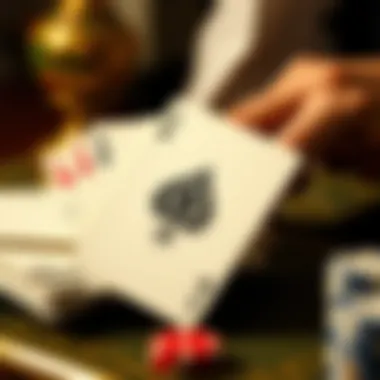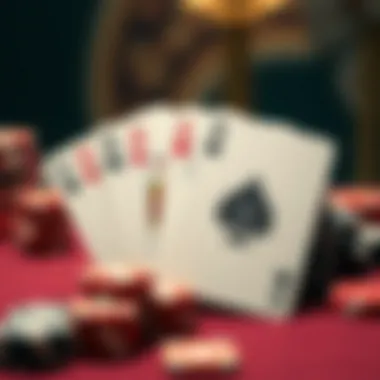The Ace of Cards: Significance in Games and Culture


Intro
The ace of cards, often the subject of much intrigue in conversations about gaming and gambling, stands as a symbol of potential, a wildcard in the arsenal of players. Weaved into the fabric of card games, its significance transcends mere numerical value. Beyond the poker tables and blackjack decks lies an extensive backdrop of historical and cultural narratives that enrich its character.
This article serves as a detailed exploration of the ace, unpacking its historical origins while delving into how it has shaped the landscape of betting and entertainment. For players and enthusiasts alike, understanding the role of the ace extends into strategic thinking, psychological awareness, and probabilistic evaluation, factors crucial for gaining an edge in gameplay. Whether you're striving to master poker or simply want to appreciate the deeper workings of gambling culture, your journey begins with the ace.
Betting Strategies
When venturing into the betting realm, having informed strategies is paramount. The ace can be a critical component in shaping your approach to wagering, guiding decisions that could lead to big wins or frustrating losses. It’s not simply about luck; understanding how to manage your trials and tribulations—even when you hold an ace—is essential.
Bankroll Management
Effective bankroll management sets the stage for long-term success in gambling. Here are some pivotal points to consider:
- Set Limits: Determine a clear budget for your gambling endeavors. Never gamble with what you can’t afford to lose.
- Divide Your Funds: Allocate a specific percentage of your bankroll for each session. This helps in curbing losses and extending your playtime.
- Track Your Bets: Monitoring wins and losses offers valuable insight into your betting patterns, allowing for adjustments.
- Know When to Walk Away: Recognizing the right moment to stop can save you from unnecessary losses, irrespective of how tempting that ace might be.
Analyzing Betting Odds
Understanding betting odds contributes greatly to making informed gambling decisions. The ace, depending on the context, can enhance the odds dramatically:
- Percentage Odds: Recognizing how often an ace will come up gives players a statistical edge. Knowing that drawing an ace can complete a hand in blackjack or elevate a poker hand dictates one's strategy under pressure.
- American vs. Decimal Odds: Familiarize yourself with these formats to interpret them correctly. Odds can fluctuate based on the game, so a good sense of value is key.
- Situational Analysis: Each betting occasion presents unique circumstances. Tailor your approach according to whether you're facing a conservative player or a risk-taker. The ace could mean different strategies in each scenario.
Poker Tips
In the world of poker, the ace possesses a duality—acting as both a powerful ally and a deceptive foe. Strategies can pivot dramatically as the game unfolds, and recognizing these shifts is essential.
Essential Poker Hands
Understanding the various poker hands that can feature an ace can greatly influence gameplay. Here’s a rundown of notable hands:
- High Card: An ace serves as the highest card when no players have a strong hand. Its position holds weight.
- Pair of Aces: Holding a pair of aces can put you ahead, but beware of possible higher pairs.
- Straight and Flush: An ace can be your starting or finishing card in both straights and flushes, adding layers of strategy to your plays.
Reading Opponents
Reading the table goes beyond just the cards dealt; understanding your opponents is equally important. When you have an ace, observe:
- Betting Patterns: Are they aggressive or conservative? Does their betting fit the hand they claim to have?
- Body Language: Watch for tells—nervous habits or confident stances can offer hints.
- Game History: Familiarity with how opponents react in various situations can inform decisions, especially when the ace enters the fray.
"In poker, just as in life, it's not always about the cards you're dealt but how you play your hand."
Understanding the nuances surrounding the ace not only equips players for better decision-making but also enriches the overall gaming experience. As we move forward, we will embark on exploring the intricate psychological elements and probabilities tethered to the ace—deepening our understanding of its role and implications.
Foreword to Playing Cards
Playing cards represent more than just colorful bits of cardboard; they embody a rich tapestry of history, culture, and strategy. They serve as a bridge connecting generations, providing endless hours of entertainment as well as insight into human behavior. Understanding the nuances of playing cards is essential for gamblers, hobbyists, strategists, and analysts, as it offers a grounding in not only the mechanics of games but also the societal implications of card play.
The History of Playing Cards
The origins of playing cards are somewhat murky, steeped in folklore and mystery. The first known instances trace back to ancient China during the Tang dynasty (618-907 AD). These early cards were likely made from paper but it wasn’t until they traveled to Persia and India that the concept began to evolve. By the late 15th century, the game caught fire in Europe, with distinct suits and designs emerging.
A fascinating story highlights how the French deck, which we largely use today, came about. In the 15th century, French card makers rejected the complex designs of German cards, leading to simpler and more elegant designs, including the heart, diamond, club, and spade suits. This historical transition wasn’t just an aesthetic change but also created a standardized system that allowed for easier manufacturing and broader adoption.


"The evolution of playing cards is really a reflection of cultural exchange through trade, war, and colonization."
Evolution of the Deck
Over time, the structure and significance of the deck have seen remarkable evolution. Initially, decks varied widely depending on location, with some featuring more than four suits or additional cards, like the trump cards seen in Tarot. The idea of a standardized 52-card deck only solidified in the 18th century and became prevalent in various card games such as Hearts, Poker, and Bridge.
The back designs of cards also tell a tale. Early cards were decorated simply, often with one-tone colors. Nowadays, there are limitless customizations, catering to every theme imaginable. From vintage floral patterns to modern illustrations or even pop culture icons, the choices reflect individual personalities and preferences.
Major Points
- The origins of playing cards come from ancient China, with a global journey that reflects cultural synthesis.
- The French deck solidified many of the features we recognize today, like suits and card values.
- Design and aesthetic changes over the centuries show the adaptation of cards to societal trends and figures.
- The evolution of the card deck to a standardized form allowed games to flourish across different regions.
By tracing the history and evolution of playing cards, we're not only looking at a game but also a reflection of the society that plays it. Understanding this can enrich our appreciation for the simplicity and yet complexity behind every deck.
Understanding the Ace
The ace of cards stands as a pivotal element in the universe of playing games. To grasp the full essence of the ace, one must explore its layered meanings and prominent role across various contexts. The ace is not merely a card; it embodies opportunity, power, and a glimpse into one’s fortune. Throughout the various sections of this article, the significance of the ace unfolds—its impact rippling through card games, gambling strategies, and even psychological tactics. This understanding heightens one’s appreciation of the nuances that accompany gameplay, making it essential knowledge for anyone looking to dive deeper into the realm of cards.
Symbolism of the Ace
The ace is frequently viewed as a symbol of extremes—both victory and defeat, chance and strategy. In many card games, the ace can either usher in a win or signal loss. This duality is what makes the ace particularly fascinating. For example, in poker, the ace might be the coveted high card in royal flushes, but at the same time, it can also be the lightest card, making it a wildcard of sorts. Its representation shifts according to the context of the game.
- In the Tarot, the ace represents the potential for new beginnings, the spark of creation, and the urge to start anew.
- In card games like blackjack, the ace can take on a value of either 1 or 11, enabling players to pivot their strategies according to the circumstances.
This flexibility positions the ace as an ever-changing entity within the card deck, signifying that life itself presents choices that can lead to unforeseen twists and turns.
Classification of Aces in Card Games
When it comes to card games, understanding the classification of aces broadens one's tactical perspective. Not all aces are equal, and their classification often drives how players approach their hand. Consider these classifications in varying games:
- High Card: In games like poker, an ace often ranks as the highest card, signifying its strength.
- Wild Card: In some variations, especially in games where players want to amp up the stakes, an ace may serve as a wild card, representing the ability to substitute for any other card.
- Low Card: Conversely, in others, an ace might be seen as the lowest card, which adds an interesting twist to how it’s used strategically.
Having a firm knowledge of how aces function in specific games not only allows players to optimize their hands but also elevates the overall gaming experience. The ace acts as a linchpin in many situations, infusing gameplay with suspense and the thrill of possibility. Understanding its role can mean the difference between a strategic success or a foiled attempt, making it an essential piece of the card-playing puzzle.
The Role of the Ace in Poker
When discussing the intricacies of poker, the ace emerges as a pivotal element, shaping the game in ways that go beyond mere luck. Its presence can dictate strategies, alter hand values, and even affect the psychology of players. Understanding the role of the ace is essential for anyone looking to sharpen their poker skills.
Aces in Hand Rankings
In poker, hand rankings are of utmost importance. The ace is not just a high card; it can serve multiple purposes, depending on the game being played. In games like Texas Hold'em, the ace can be a part of high hands, or it can contribute to creating a low hand when used strategically. This duality underscores the significance of the ace:
- High Card: Aces have the highest rank in poker when compared to any other card, making them a prime candidate for top hands.
- Straight and Flush: An ace can also be incorporated into straights and flushes, creating potent combinations: (e.g., A-2-3-4-5 is a straight known as a wheel).
- Low Hand: In some versions of poker, like Lowball, aces can represent low values, thus further enhancing their utility.
The role of the ace in hand rankings sets it apart, granting players exceptional versatility and fostering dynamic gameplay.
Strategies for Using the Ace
Successfully leveraging the power of the ace requires more than just being dealt one. Here are several strategies that players should consider:
- Aggressive Play: When holding an ace paired with a strong kicker, playing aggressively can put pressure on opponents, potentially forcing them to fold weaker hands.
- Bluffs and Semi-Bluffs: Knowing how to use the ace in bluffing situations can be a game-changer. A well-timed bluff with an ace can sway the outcome of a hand, especially if you have demonstrated strength earlier in the game.
- Reading Opponents: Paying attention to how other players respond to an ace on the table can provide insights into their hands. If a player suddenly becomes tight after an ace appears, they might have an ace.
- Position Play: In late positions, an ace can be used strategically to call raises, helping you capitalize on opponents’ tendencies. Understanding the table dynamics is crucial for optimizing your strategy with aces.


Utilizing the ace effectively not only enhances your odds of winning but also solidifies your image as a seasoned player. Knowing when to flaunt your ace and when to play it close to the vest is a finely tuned skill that comes with experience.
"In poker, aces are like a wild card; wield them wisely to shape the fate of your game."
A nuanced grasp of the ace can create substantial shifts in gameplay, enabling players to navigate through intricate scenarios and emerge victorious. For those seeking to enhance their poker prowess, focusing on aces and their strategic potential is logical, yielding rewarding insights into the dynamics of poker.
Psychological Aspects of Aces in Card Games
The psychological dynamics surrounding the ace in card games cannot be understated. The ace, often regarded as the highest card in many games, holds a unique place in the minds of players. Understanding these psychological aspects provides valuable insights for enthusiasts and strategists alike. Here, we delve into risk and reward dynamics, as well as the art of bluffing associated with this coveted card.
Risk and Reward Dynamics
The ace embodies a dichotomy of risk and reward in card games. When a player holds an ace, the potential for a win is high, but so is the psychological burden. Players must weigh their options with caution. The feeling of possessing an ace can create overconfidence, leading to erratic decision-making. For example, a player might be tempted to raise their bet aggressively, underestimating opponents who might not reveal their strength.
Moreover, the availability of the ace during a hand can shift game dynamics dramatically. When multiple players are contesting for the same high-value card, it intensifies the stakes, creating an atmosphere thick with anticipation. Players find themselves contemplating not just their own hand, but also the possible holdings of their opponents.
Consider the following points regarding risk and reward with aces:
- Motivation: Players are often driven by the allure of landing a significant win, but the ratio of risk can lead to unexpected losses if not managed properly.
- Emotional Pressure: The presence of an ace can heighten the stakes emotionally, urging players to act based on impulse rather than sound strategy.
- Opponent Reading: Recognizing how opponents react to the possibility of aces can give a player a strategic edge. Whether it's folding or bluffing, knowing when to pounce can mean the difference between winning big and walking away empty-handed.
Bluffing and the Ace
Bluffing is a cornerstone of card play, and the ace plays a formidable role in this psychological tactic. The mere presence of an ace can cause opponents to reassess their hands, often leading them to make hasty judgments based on misinformation. A player might leverage the ace as a tool to mislead and manipulate perceptions at the table.
Bluffing with an ace, however, requires finesse. A player must be able to project confidence while reading the opponents’ reactions closely. The nuances are subtle; a well-timed bluff can coax opponents to fold hands they may have otherwise played. Here are some key takeaways on bluffing with aces:
- Timing is Everything: Initiating a bluff when the board reflects favorable conditions for holding an ace can increase its efficacy.
- Player Patterns: Observing a player's tendencies can provide insight into their likelihood of folding, allowing you to tailor your bluffs effectively.
- Psychological Warfare: Using the ace as a deceptive tool can turn the tide of a game, shifting the psychological advantage to the bluffing player if executed adeptly.
"The ace is not merely a card; it's a mindset that influences the entire game."
For additional reading on psychological strategies in poker, you can explore resources like Wikipedia or delve into specialized communities on Reddit.
The Odds Associated with Aces
Understanding the odds associated with aces is a crucial element in evaluating card games. The ace holds a unique position in the deck, and its value can fluctuate depending on the context of the game being played. This section aims to illuminate the various probabilities surrounding aces, offering insights that will be particularly useful for gamblers, strategists, and enthusiasts alike.
Probabilities in Poker
When it comes to poker, the importance of probabilities can’t be overstated. Aces in poker can serve as powerful assets, but their impact hinges on the likelihood of their appearance in specific hands. Here are some key points to consider:
- Pre-flop Probabilities: The chance of being dealt an ace as your starting hand is about 15.7%, considering there are four aces in a standard deck of 52 cards. This can heavily influence one’s starting stance in a game.
- Post-flop Dynamics: Once the community cards are revealed, the possibilities of forming strong hands become vital. For instance, if you already hold an ace, calculating the odds of pairing it with another ace on the flop, turn, or river is fundamental to making informed betting decisions.
- Occurrences in Different Game Variants: The probabilities of aces manifest differently in varieties like Texas Hold'em versus Seven Card Stud, as the number of visible cards changes drastically. Understanding this can alter your strategy and how you perceive your hand against opponents.
"In poker, it’s not just the cards you hold, but the odds behind them that truly dictate your success."
Calculating Potential Outcomes
Calculating potential outcomes with aces requires a more methodological approach. By using mathematical principles, players can derive the likelihood of various scenarios playing out.
- Counting Outs: A player needs to know how many outs they have after the flop or turn. For example, if you have one ace, and there are three left in the deck, you could quantify potential outcomes by assessing how those cards might fit into your hand or provide strategic leverage over competitors.
- Risk Assessment: Players can employ risk analysis by evaluating scenarios where they might not only improve their own hand but also block opponents from achieving stronger hands. Calculating this entails understanding what hands aces might help support.
- Statistical Models: For the mathematically inclined, statistical models could aid in predicting outcomes based on a variety of factors including player behavior, history, and current table dynamics. This comprehensive analysis allows for better adjustments during play and informed betting actions.
Cultural Implications of the Ace


The ace of cards is not merely a playing piece; it stands as a symbol of complexity, intrigue, and deep cultural meaning across different societies. Understanding this role provides insight into how this single card can represent themes of power, hope, and risk-taking in various forms of art and literature, as well as influence subtle shifts in social dynamics through gameplay.
The Ace in Literature and Art
In literature, the ace often symbolizes triumph against the odds or the notion of hidden potential. For example, in many narratives, the protagonist who wields an ace represents someone who adapts and strategizes effectively to overcome challenges. Literary works such as
The Ace in Modern Gambling
The ace of cards holds a prominent place in the world of modern gambling, morphing from its traditional roles into a powerhouse symbol of strategy and risk. As technology and gaming platforms have evolved, the ace has adapted, becoming more than just a card but a powerful element in various forms of gambling today. This section aims to explore why the ace is crucial in this context, especially for those who dabble in online poker and casino gaming.
The ace's designation as a high-ranking card has embedded it with unique strategic significance. In poker, for instance, it can serve both as a high card and a low card, allowing players to employ it in versatile manners depending on the game situation. This dual nature lends itself to both tactical play and psychological advantage, providing layers of complexity that can benefit knowledgeable players.
Moreover, understanding the dynamics surrounding the ace has tangible benefits for gamblers. Recognizing when to play aggressively with an ace or when to fold can dictate the outcomes of a hand. This understanding can smooth the path for building a strategy that capitalizes on probabilities and psychological cues. Additionally, the way the ace interacts with other cards in poker hands can affect not only a player's strategic decisions but also their opponents' perceptions and responses.
"In gambling, like in life, understanding your cards can mean the difference between survival and success."
The risks also come into play. Players might feel tempted to overvalue an ace, mistaking its presence as a guarantee of victory. A seasoned gambler, however, should balance the allure of high expectations with a keen understanding of odds and the fluctuating nature of card games. This delicate balance is integral to achieving longevity in gambling pursuits.
Online Poker and Aces
Online poker has exploded in popularity over recent years, making it a cornerstone of modern gambling. In this setting, the ace's value is amplified due to the anonymity and high stakes involved. Players often find themselves navigating a virtual landscape where facial expressions and body language, tell-tale understandings in live games, are absent. Thus, the ace becomes a pivotal tool not just for winning hands but for manipulating opponents' behaviors.
When it comes to strategies specifically involving the ace in online poker, players must be astute in how they present their hands. For instance, a player holding an ace alongside a low card might raise the stakes aggressively, leading their opponents to think they are holding a stronger hand than they do. The lack of physical tells in online poker encourages this type of strategy, allowing the ace to play a central role in bluffing and deception.
Additionally, the ace's presence in online formats can shift the overall dynamics of a game. With so many players online from diverse backgrounds, the statistics about how often an ace appears in play can shape betting strategy, ultimately affecting winnings in the long term.
Aces in Casino Gaming
In the realm of brick-and-mortar casinos, aces continue to dominate several games beyond just poker. Take blackjack for example. The ace's role is paramount in this game, where it can count as either one or eleven, providing players with a remarkable strategic edge. This flexibility often dictates how bets are placed and how players approach the game overall.
In other casino games, such as baccarat or even certain slot machines, the significance of the ace is also felt, though in different contexts. Here, the card may not hold the same ranking as in poker or blackjack, yet gamblers understand its historical and cultural weight, making it a surefire crowd-pleaser.
It's essential to note that the impact of aces in casino gaming extends beyond the gameplay itself. The sheer excitement that accompanies the specter of an ace being dealt heightens the overall atmosphere of the gaming floor. Players often exhibit louder cheers and collective gasps whenever an ace appears, whether in hand or drawing from a shoe. This cultural excitement feeds into the entertainment aspect of gambling, making the ace a cherished talisman for many.
Culmination: The Enduring Legacy of the Ace
The ace of cards stands tall in the hierarchy of playing cards, as a symbol of triumph and strategy. Its timeless presence in various game settings, from poker tables to casual family gatherings, highlights its enduring relevance. Understanding why the ace is revered requires a look through its history, cultural significance, and psychological impact on players.
The ace is not just another card; it embodies the essence of risk-taking and potential reward. Within the frameworks of numerous card games, it represents a duality. An ace can elevate a hand to new heights yet may also signify danger for the unprepared. This dual nature invites players to delve deep into strategy, analyzing when to play it safe or go all-in. In poker, the ace's value fluctuates, sometimes being the most potent card, while at other times posing as the potential downfall of a player who overestimates its power.
Notably, the ace acts as a bridge between generations. It holds a cherished spot in traditional games, revealing the joy of interaction that transcends age barriers. Families enjoy passing down their unique strategies, rich delineations of success or failure centred around the ace. This not just nurtures the spirit of competition but also strengthens bonds, ensuring that the ace remains a part of both old school and modern gaming.
In recent decades, as technology integrates deeply into gaming, the ace has adapted splendidly. Online poker rooms and casino platforms breathe new life into what the ace represents through digital gameplay. Players can now face off against others from around the globe, all while the ace remains a centerpiece of strategic explorations.
To summarize, the ace is not merely a card; it is a legacy woven through the fabric of card play, symbolizing not just victory, but the enduring spirit of human competition.
Key Takeaways about the Ace
- The ace is often the highest-ranking card in many games, but its value can change based on the context.
- The psychological factors at play when using an ace can be as crucial as its numerical value.
- Its rich history plays a key role in bridging generational gaps through family games and traditions.
- Modern technology has not overshadowed the ace but has rather elevated its significance within online gaming.
The Future of Aces in Gaming
As we look ahead, the future of the ace in gaming appears promising, especially with the rise of e-sports and online card games. New gaming platforms are emerging rapidly, incorporating virtual reality and augmented reality, giving players the ability to experience the thrill of holding an ace in a hyper-realistic environment. The ace's universal appeal remains strong, and its presence in various media will continue to foster interest.
Gamblers and enthusiasts will likely continue to explore the ace's strategic importance, finding innovative ways to integrate it into future games. As players become more educated in probability and tactics, the ace may transform from a mere card into a symbol of mastery and decision-making prowess.
In closing, whether it be through a physical deck on a table or a virtual card room online, the ace is set to maintain its iconic stature. The blend of history, strategy, and evolving technology guarantees that the ace will remain a focal point for gamblers and card game aficionados alike in years to come.







